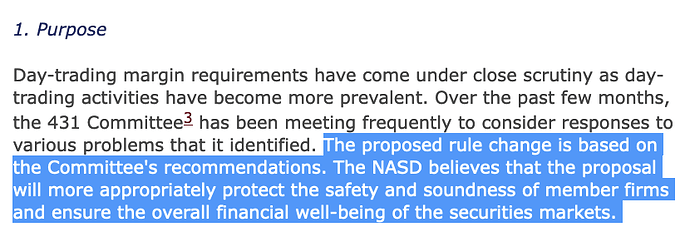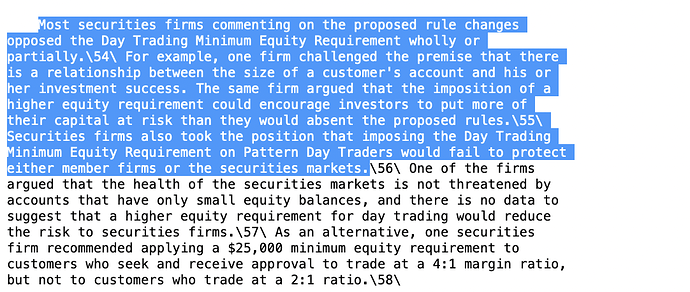The Pattern Day Trading Law arbitrarily requires that investors who buy and sell the same security on the same day must maintain $25,000 or risk having their brokerage account deactivated.
The outdated PDT restrictions unfairly target investors with under $25k and do precisely nothing to protect investors and markets. If America values competition and free enterprise, why is gambling legal, yet small investors trading multiple times per day forbidden?
Instead of limiting borrowing/leverage, the plutocratic PDT rule forces small investors to take on more risk by not enabling them to close out positions (to reduce risk) on the same day.
What is the purpose of gatekeeping market access?
From the SEC in February 2000:
Source: SRO Rulemaking: SR-NASD-00-03
In order to “ensure the overall financial well-being of the securities markets,” it’s necessary for investors who make 4 or more day trades in 5 days to maintain a < begin sarcasm > rigorously and mathematically derived < end sarcasm > minimum of $25k. Even if an investor’s trades are defined-risk and fully collateralized, the arbitrary rule still applies. Institutional investors are exempt, of course.
July 27, 2000: “Even more important, it is critical that day trading firms discourage the opening of day trading accounts for customers who do not possess the financial means or goals to suitably pursue day trading as a career.”
Why is it the SEC’s job to restrict market access to people whom they deem “do not possess the financial means or goals to suitably pursue day trading as a career”?
Source: DAY TRADING: CASE STUDIES AND CONCLUSIONS
What’s the basis for the PDT market restrictions?
Source: SRO Rulemaking: SR-NASD-00-03
How do regulations restricting free-market access from less wealthy investors “promote just and equitable principles of trade and protect the investing public”?
With trillions of dollars of assets traded daily and the advent of high-frequency market making, are accounts with under $25k who trade a few times per day really a market risk that needs to be protected against? Are paternalistic restrictions locking out small investors from capital markets really “protecting” them? Why is the government locking less capitalized individuals out of markets?
The SEC acknowledges that “Securities firms took the position that imposing the Day Trading Minimum Equity Requirement on PDT would fail to protect either member firms or the securities markets.”
Source: Federal Register, Volume 66 Issue 44 (Tuesday, March 6, 2001)
Fortunately, the SEC maintains a constantly-updated database of evidence supporting the efficacy of the PDT law. Here’s the link: just kidding.
@GaryGensler still hasn’t responded
Extra clarification on the risk-based and pro-market rules: "If, after a termination of pattern day trader status, a customer again engages in pattern day trading, such customer’s pattern day trader status may not be terminated absent extraordinary circumstances. "
With one exception, of course.
Free markets are not truly free if the government makes arbitrary, evidence-less, and plutocratic rules that restrict the trading of small accounts that can improve markets and add liquidity.



